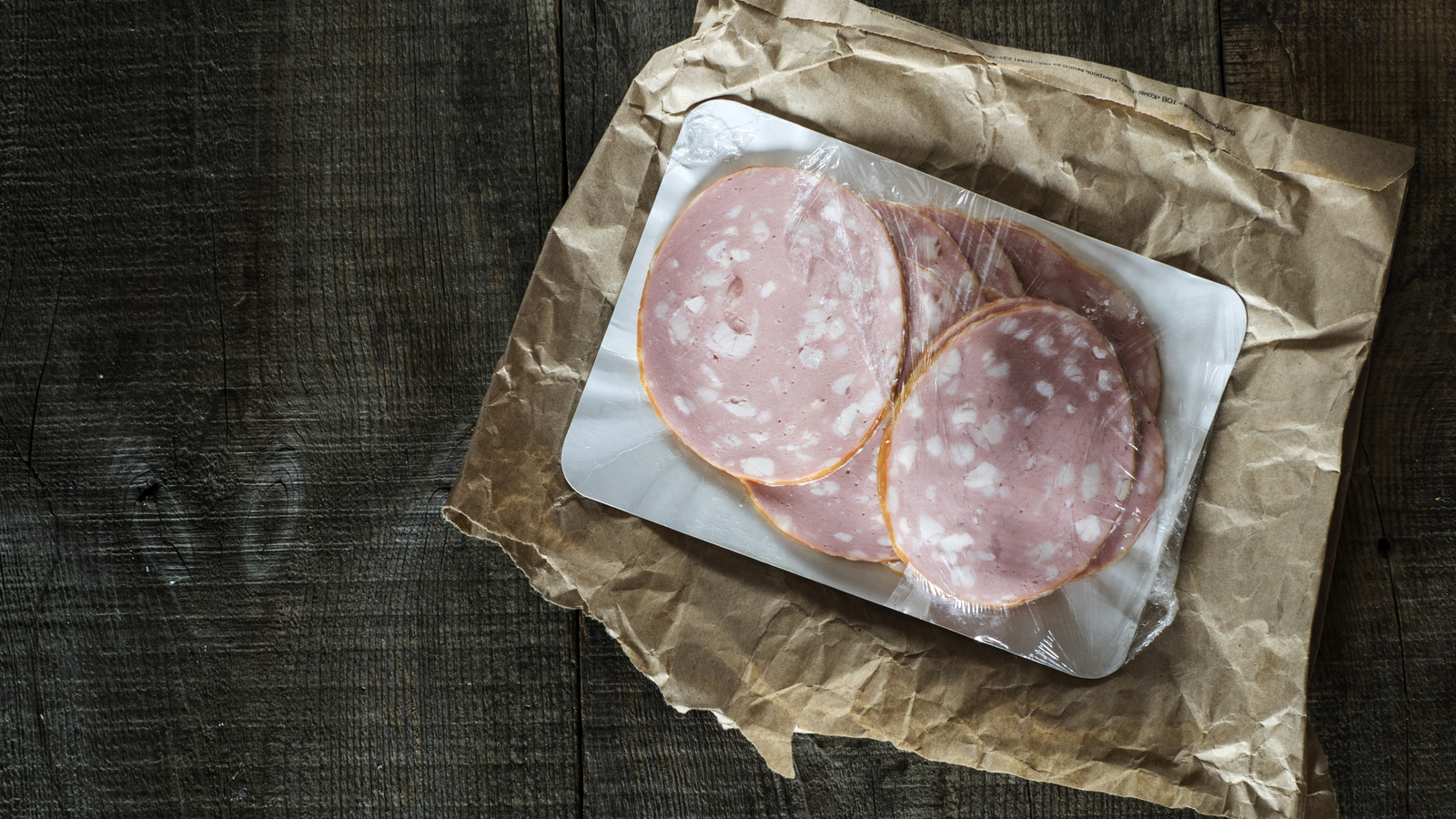You’re at a friend’s party, mulling over the charcuterie board. You see some of your favorites: salami, prosciutto, maybe even some bresaola. But then you see it: a sort of processed-looking meat that’s roughly reminiscent of bologna. No — Oscar Meyer certainly wouldn’t make an appearance here, would he? Whether those thinly cut, pink meat rounds are relatively plain-looking or are studded with colorful green pistachios, you’re probably looking at mortadella, arguably one of the trendiest types of charcuterie you’ll see on meat boards.
However, if you’ve never come into contact with this variety of deli meat before, you may be hesitant to try it. After all, how can it compare to the fattiest, richest, most delicious prosciutto out there? But mortadella is a thing to behold, a silky-smooth slice of meat that may just change the way you think of a simple deli sandwich. That’s why we’re digging into what, exactly, mortadella even is, how it’s made, and why — despite the similarities in appearance — it’s actually not the same thing as bologna at all.
What is mortadella?
If you like fatty cuts of deli meat with strong, salty flavors, then there’s a good chance that you’ll love everything that mortadella, which hails from Bologna, Italy, has to offer. It’s a type of sausage that’s made with pork and cubes of fat, which is combined with a variety of other flavorful ingredients, like pistachios or black pepper, to create a super bold cured meat. It often has a spotty appearance to it, which comes from the hunks of fat throughout the meat. This gives a slice of mortadella a lovely, silky texture that tastes just as good on its own as it does in a sandwich.
There are so many different ways to serve mortadella. Sometimes, you might see it as a sliced appetizer, particularly in Italy. In Brazil — as in other countries — it’s served as a sandwich, stacked high with ultra-thin slices of the meat. Plus, you can incorporate it into pasta dishes or even pack it into ravioli for a salty, meaty filling.
How is mortadella made?
First, the meat is chopped or ground into tiny pieces. Generally, this will include large portions of fatty meat along with lean meat, as well. They’re then mixed with herbs and spices, which give mortadella its bold and salty flavor. Then, the meat is cooked in dry-air heaters, a process that takes several hours. The exact time will vary based on the size of the mortadella sausage in question. Once it’s taken out of the oven, the meat is rinsed in cold water and allowed to come to room temperature. After that, it’s sliced and packaged and eventually gets sent to a store or a restaurant where the consumer ultimately purchases and eats it.
Although mortadella production sounds tricky, it actually is possible to make it at home. That being said, it’s a labor-intensive process, and if you’re anywhere near a deli, it might just be easier to pick some up the next time you want to dress up your charcuterie board.
Mortadella vs. bologna
Take one look at mortadella, and you might immediately think about how much it looks like bologna. However, the two deli products actually aren’t the same thing, and if you try to swap one for the other, you’ll probably soon notice their many differences.
For example, bologna is a lot more uniform than mortadella, in which chunks of fat and leaner parts of the meat are often visible just in the coloring of the cold cut. Similarly, mortadella is usually spiced and enhanced by an array of different ingredients, while that’s not traditionally the case for bologna. Therefore, mortadella usually offers a much more flavorful experience. Lastly, while mortadella is made with pork, bologna can be made with pork, beef, chicken, turkey, or a mixture of any of these meats.
These differences don’t necessarily mean that one product is better than another. When you want a cold cut with a uniform albeit salty flavor, then you should go with bologna. However, when you’re opting for a more complex, bold flavor, then mortadella is probably your best bet. The best way to tell the difference between the two, though, is to taste them side by side for yourself. Just remember that one of the main differences between mortadella and bologna is the fact that mortadella is the original, and bologna came afterwards as a spinoff of its more complex cousin.
What does mortadella taste like?
Because of how similar mortadella and bologna look to one another, you might assume that they taste mostly the same. However, that’s not really the case. Usually, mortadella is salty but not quite as salty as most bologna. Instead of all that extra salt, it boasts other interesting flavors, as previously mentioned. For example, you’ll often pick up on a note of nuttiness from the meat, and you might even get some earthy and peppery notes from the peppercorns embedded in it. Often, a blend of aromatic elements in the meat mixture will yield a bold flavor that’s hard to put your finger on, but is nonetheless delicious.
Something that really stands out about mortadella, apart from its flavor, is its texture. Mortadella is often cut quite thinly, which gives it a velvety, soft texture that tastes delicate on its own and almost chewy when stacked on top of itself on a sandwich. If you like other types of cured meat, there’s an excellent chance that you’ll enjoy mortadella, as well.
How to cook with mortadella
There are so many different ways to cook with mortadella, but honestly, you don’t have to cook it at all. It can be used in a variety of preparations that don’t really count as cooking. For example, you can simply take some mortadella slices and place them on a charcuterie board to offer an interesting texture to the spread, as previously mentioned. Alternatively, you can use them in a sandwich, like Anthony Bourdain’s easy five-ingredient mortadella sandwich, which the beloved chef was known for.
You can put mortadella on pizza for an Italian-style slice, and you can even use it as a pigs in a blanket, filling in place of the traditional hot dog. It also makes for a legendary muffaletta, which is arguably New Orleans’ most famous sandwich. Basically, you can use it in just about any recipe that calls for any other salty deli meat, from the most basic applications to full-blown recipes.
Where to buy mortadella
There’s a good chance that you’ll be able to find mortadella at a store near you, particularly if you live in an area with a prominent Italian community or a larger city. If you’re at a standard American-style grocery store, you’ll probably want to look for mortadella in the deli section. The people who work there might be able to cut some for you fresh, in which case you should tell them that you want it thinly sliced. It may also be in the refrigerated deli meat section among the cheaper varieties like bologna, but not every grocery store will have mortadella readily on hand.
If you can’t find mortadella at your local grocery store, your best bet is to go to a butcher or other specialty food store that sells charcuterie. Often, the mortadella at these kinds of spots will be more expensive, but you might also find that it’s generally higher quality, as well.
Purchase Ferrarini’s mortadella with pistachio nuts at Sogno Toscano for $9.95 per four ounces.
Purchase Italian sliced mortadella with pistachio at Olio & Olive for $7.80 for a quarter pound.
Nutritional information about mortadella
Is mortadella the healthiest food you could ever eat? Probably not. Mortadella is a processed meat, which scientists seem to agree isn’t the ideal thing to be eating on a regular basis. That’s because it’s a Class A carcinogen, which means that scientists consider it just as bad as smoking cigarettes when it comes to raising your risk of cancer — although mortadella is arguably much, much more delicious than a cigarette.
Additionally, mortadella is exceptionally high in salt, just like most deli meats. Salty foods can raise your blood pressure, which isn’t great for people who already struggle with their blood pressure without the inclusion of salty meats in their diet. Does that mean you can never incorporate mortadella into your diet? No. However, it’s probably best to moderate the amount of mortadella — and processed meat, in general — that you eat on a regular basis for optimal health outcomes.
Varieties of mortadella
You may assume that all mortadella is more or less the same, but that’s not totally true. It turns out that there are two main types of mortadella out there — there’s plain old mortadella and then there’s Mortadella Bologna. The latter is specifically produced in Italy’s Emilia-Romagna region. This type of mortadella is more likely to include different spices and can vary in terms of fattiness. Be sure to ask your local butcher about the variety you’re getting if you’re curious about its specific flavor profile.
However, you may just want to look at what ingredients are included in the mortadella of your choice. If you want that subtly nutty crunch in every bite, then consider getting a pistachio-dotted variety. On the other hand, if you’re looking for spice and earthiness, a black pepper-studded mortadella may be a better option. Ultimately, if you’re a mortadella lover, you should try out different flavors to get a sense of the types of mortadella you like best.
How to store mortadella
If you’ve ever left a charcuterie board out for a while, you may have noticed that mortadella can dry up after it’s sliced and exposed to air for long enough. Once it loses its soft texture, you might want to toss it, though. Unless you’re actively serving mortadella, it should be stored in the fridge, just like other types of deli meat. Wrap it up well or put it in an air-tight container, and you can keep it fresh for about a week.
Want to store your mortadella for an even longer period of time? You can store thicker cuts of unsliced mortadella in your freezer. It may not have exactly the same texture once you remove it from the freezer, but it should function the same way as it would fresh in most recipes. Just remember to never leave your mortadella out on the counter too long, since it could spoil, just like any other type of meat.





